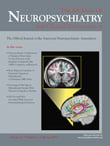SIR: Hereditary hemorrhagic telangiectasia (HHT) is an autosomal dominant vascular dysplasia that affects 1 in 5,000 to 8,000. Its clinical picture comprises nosebleeds, gastrointestinal hemorrhage, mucocutaneous telangiectasia, pulmonary and cerebral arteriovenous malformations, as well as hepatic involvement due to abnormal vascular structures. The clinical significance of this disorder has increased since asymptomatic screening programs have shown a much higher frequency of arteriovenous malformations than was initially suspected.
1 HHT can be the result of mutations in genes on at least two chromosomes. The first is in the gene encoding endoglin (chromosome 9q34;
ENG, HHT1 ). The second is in the gene encoding activin A receptor type-like kinase 1 (chromosome
12q13; ALK-1, HHT2 ).
2 There is a paucity in published clinical reports of neuropsychiatric complications despite the frequent cerebral involvement. We describe two patients who were primarily referred for neuropsychiatric evaluation without a suspected association with HHT.
Case Report
A 21-year-old man was referred because of behavioral problems. At the age of 14 he underwent an embolization for a pulmonary arteriovenous malformation. Magnetic resonance imaging (MRI) and angiography of the brain as well as an echography of the liver were normal. The patient and his mother were both suffering from HHT. Genetic analysis demonstrated a mutation in the ENG gene ( HHT1 ).
The patient’s early development was characterized by abnormal language development and disinhibited behavior. At the age of 14, he was institutionalized because of behavioral disturbances and learning difficulties. Psychological examination (SON-R) showed a total IQ of 74. He showed repetitive and stereotyped behaviors, a qualitative impairment in communication and social interaction, and episodic impulsivity with temper tantrums. In addition, paranoid ideation and hallucinatory experiences were observed. Two years later he developed bizarre behavior and intermittent psychotic symptoms. In subsequent years, his behavior became more disinhibited and aggressive, and he was referred for a neuropsychiatric reevaluation. Somatic examination demonstrated telangiectases on the mucosa of the mouth and nose. Extensive laboratory tests did not show abnormalities except a slight elevation of the liver function tests.
A diagnosis of pervasive developmental disorder and borderline mental retardation was made. Before extensive somatic, neuroradiological, and neuropsychiatric examination could be completed, the patient died suddenly due to a massive pulmonary bleeding. An autopsy was not performed.
Case Report
A 58-year-old woman had been psychiatrically admitted for the first time at the age of 23, most probably because of a psychosis. At the age of 42 she was referred to the outpatient department because she felt overstrained and unable to cope with daily events. At that time, her mood was dysphoric and irritable, her thoughts were chaotic, and she spoke circumlocutorily. No formal psychiatric diagnosis was made. In the subsequent 16 years, no psychiatric intervention was necessary.
Recently, she was admitted because of a manic episode with prominent religious delusions, incoherence of speech, euphoric mood, disinhibited behavior, and poor social judgment. Somatic examination demonstrated multiple telangiectases in the nose and on the tongue and pinpoint telangiectases on the fingertips as well as temporary mild hematuria. Extensive laboratory tests did not show any abnormalities. Neuropsychological examination demonstrated a total IQ of 72 (WAIS-III) and slow mental processing.
MRI scanning of the brain revealed no signs of cerebral complications. A computed tomography (CT) scan of the lungs showed a small arteriovenous malformation with a diameter of 5 mm. Her somatic history mentioned recurrent epistaxis, uterus extirpation, venous varicosities and hypertension. No family history with psychiatric disorders was present. Based on the trials, epistaxis, telangiectasias, and positive family history, the diagnosis of HHT was established that was genetically confirmed as a mutation in the ALK-1 gene (HHT2).
Comment
Although HHT has a relatively high prevalence, it is remarkable that virtually no psychiatric complications have been described. Psychiatric disorders in HHT may develop shortly after adolescence and present with schizophrenia-like symptoms with or without accompanying liver cirrhosis.
3 In addition, a paradoxical cerebral embolism may occur from silent pulmonary arteriovenous malformations, especially in cases with the
HHT1 type. Furthermore, transient ischemic attacks may occur regardless of the degree of respiratory symptoms. Finally, a disturbed angiogenesis with fragility of small vessels may be involved in brain dysfunction and neuropsychiatric symptomatology.
4Recently, it was suggested that the neurovascular manifestations show age-related penetrance with an increased prevalence of cerebral manifestions over the lifespan.
5Although a causal relationship between HHT and psychopathology cannot be demonstrated in the presented cases, it is worthwhile to consider brain manifestations of the disease, including neuropsychiatric complications, that manifest via different pathways. It is therefore highly remarkable that no neuropsychiatric complications of HHT are reported in the literature.

